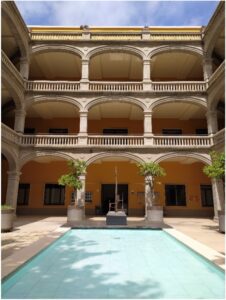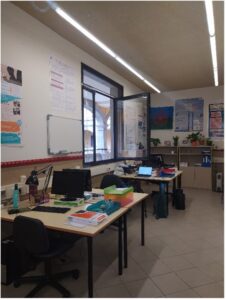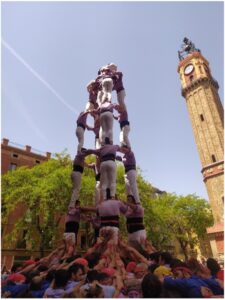Archive for June, 2022
My internship in Norway at Kverneland Energi
- M.Sc. Mechanical Engineering
- Norway, Kvernaland (living in Stavanger)
- Kverneland Energi
- 04.04.2022 – 30.06.2022
On April 1st I arrived in Norway and my first day of work was the 4th of April.
Kverneland Energi is a company that installs PV-systems, plans and installs battery systems and develops the software for projects that either just rely on generators and batteries or additionally use PV panels. My entry in the company started with learning the basic installation process of PV- systems on three different kinds of roofs:
1.flat roofs, which are mostly seen in industry applications
2.steel roofs often used in agriculture; a very interesting sector with wide availability of space for PV- systems and interest in the investment mostly to self-sustain the farmland; and
3. the classic gable roof with tiles, which can either have a hook-system to install the panels ‘on top’ of the tiles or alternatively the pricier option of an embedded PV-system
I worked for the first half of my three months stay in the installing sector of the company and got to know the difficulties and intricacies, which each different kind of project presents. The weather in April in Norway is tough
to predict and I experienced pretty much every time of the season in those 6 weeks –
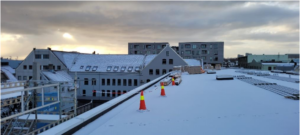
© Adrian Bodamer
starting with snow in week 1 of work and ending with summer like conditions in May, the part that needs most getting used to is the 8-hour work in constant rain. Stavanger is notorious for being city being blessed with rain, but thanks to the golf stream the extreme temperature drops are not too common there and therefor snow is rare. A one-hour drive to Sirdal is not only one of the most impressive road trips I have ever taken, it also completely changes the scenery and climate – presenting itself with at least half a meter of snow in the around easter.
That being said, I got quite lucky, and we mostly worked in sunny weather conditions – with wind presenting the biggest challenge. Carrying and installing the panels in these conditions can be very tricky and presents the engineers with the challenge of providing a system that is able to sustain all kinds of weather challenges on a constant basis.
After 6 weeks outside I joined the software programmers in the office space in Kvernaland, around 30minutes outside of Stavanger. There I worked closely with Andreas, an electrical engineer on a project which runs off grid. The cabins located in ‘Stranddalen’ are about a 1.5h hike away from the next closest village and require an energy system without a grid connection – relying on a generator and sunlight.
With a combination of a large generator, solar panels, and a battery system the cabins can self- sustain for the
3-4 month opening period, starting
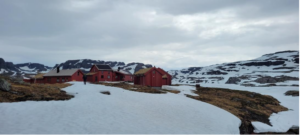
© Adrian Bodamer
in the middle of June. During the winter, the batteries are discharged and must handle temperatures around -10°C over weeks, the panels need to sustain meters of snow pressing down on them. All these extreme weather conditions make this project incredibly exciting!
This project started as the bachelor thesis for Andreas, and my job for most of my time in the office was to program a updated plan to improve the efficiency of when the generator needs to be active, and when the PV-power and battery system can supply the cabins without the use of fuel. Challenging in that was the variation in consume, produced PV current and request of the customer to not run the generator from 9pm to 8am. The battery system is the most important thing to avoid running the generator too often and use unnecessary fuel. Working with data collected over the last 2 years and realising patterns about consume and production, Andreas, Sjur and I implemented the new code created in TIA portal by visiting the cabin and accessing the electric system at the cabins.
Before the visitors and personal come to the cabin, the new system needed to be implemented. A 2-hour hike with increasingly more snow on the path the further we went up the mountain in the middle of June was one of my most surreal
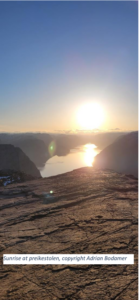
© Adrian Bodamer
experiences and showed me (once again) the stunning beauty of Norway! And the 2-day stay with my two Norwegian co-workers that I had to this point known for only a few weeks was amazing and I always felt very welcome – and that was the case pretty much everywhere I went in Norway.
Without ERASMUS, this trip would have not been possible for me – it was tough to find a place to live for short term rent that was also affordable. Same goes for every day needs like groceries or public transport tickets – everything is more expensive here, without exception. If you plan on having a less stressful time in Norway, then a good approach would definitely be to make a spending plan before arriving. And if you have a car, I would very much advise you to drive it up to Norway if you want to see much of the country as public transport is definitely improvable to say the least. My 17-hour trip from Aachen to Stavanger by car was exhausting but the best decision I made coming up here – though not very sustainable I have to admit. If you ever get the chance to travel to Norway: take it, it’s absolutely worth it!
My experiences in Trondheim, Norway
- Business Administration and Engineering Materials and Process Engineering, M. Sc.
- Trondheim, Norway
- NTNU Trondheim
- 01.04.2022 – 31.05.2022
My experiences:
I am solely responsible for the content of this report.
During my master thesis which I am writing in collaboration with the NTNU in Trondheim and RWTH in Aachen I spent two months in Trondheim.
Preparation
Since I was already in Trondheim the semester before as an exchange student, I was quite familiar with the city, university as well as with the application procedure. During my exchange semester I attended the course MFA I (Material Flow Analysis) with Prof. Müller and decided to write the upcoming master thesis together with him and the RWTH.
After gathering some information, the application was very easy and quick. The next step was then the application/registration at the NTNU to get the student rights etc. and to be also able to apply for student accommodation through SIT (the organisation which provide the accommodations and other things in Trondheim). I received the confirmation of both in time so I could plan all the rest.
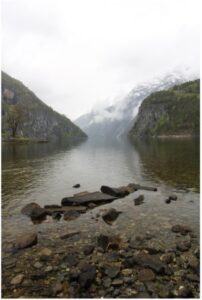
© Moritz Langhorst
Office routine
During the two months I felt very welcome at the department and was able to work in the study room with all the other students writing their master thesis. This was a good way to get to know them and to see on which topics the other students and researchers in the group are working. My weekly meetings with my supervisors could now also take place in person, which was very helpful for the working progress. I could also participate in the regular group meetings of the research group where the researchers of the group are presenting their work.
Leisure
Because I still knew some people from my exchange semester, it was very easy to find a lot of activities for the time besides the thesis. On weekends we went on a lot of cabin trips in the surrounding area, spent evenings on the fjord to watch the sunset, went bouldering or in bars. Trondheim has especially for students a lot to offer. A very nice coincidence was that the 17th of May, which is the national holiday in Norway, was in my time in Trondheim. This was a perfect opportunity to get to know the Norwegian culture, starting with a brunch and parades in the city.

© Moritz Langhorst
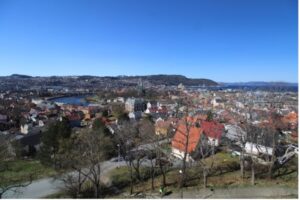
© Moritz Langhorst


